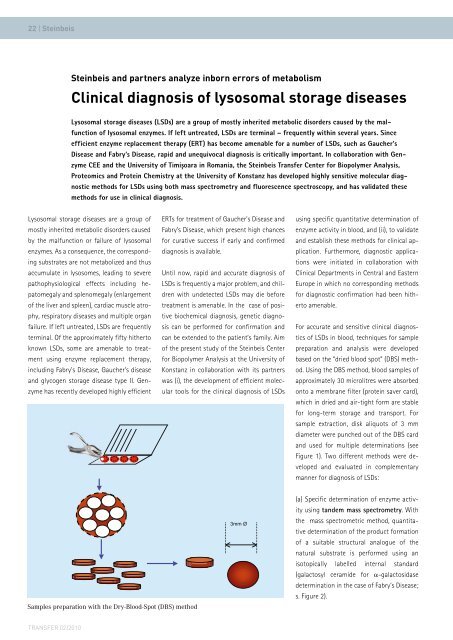transfer - Economic Development and Employment Promotion: Project
transfer - Economic Development and Employment Promotion: Project
transfer - Economic Development and Employment Promotion: Project
You also want an ePaper? Increase the reach of your titles
YUMPU automatically turns print PDFs into web optimized ePapers that Google loves.
22 | Steinbeis<br />
Steinbeis <strong>and</strong> partners analyze inborn errors of metabolism<br />
Clinical diagnosis of lysosomal storage diseases<br />
Lysosomal storage diseases (LSDs) are a group of mostly inherited metabolic disorders caused by the malfunction<br />
of lysosomal enzymes. If left untreated, LSDs are terminal – frequently within several years. Since<br />
efficient enzyme replacement therapy (ERT) has become amenable for a number of LSDs, such as Gaucher’s<br />
Disease <strong>and</strong> Fabry’s Disease, rapid <strong>and</strong> unequivocal diagnosis is critically important. In collaboration with Genzyme<br />
CEE <strong>and</strong> the University of Timişoara in Romania, the Steinbeis Transfer Center for Biopolymer Analysis,<br />
Proteomics <strong>and</strong> Protein Chemistry at the University of Konstanz has developed highly sensitive molecular diagnostic<br />
methods for LSDs using both mass spectrometry <strong>and</strong> fluorescence spectroscopy, <strong>and</strong> has validated these<br />
methods for use in clinical diagnosis.<br />
Lysosomal storage diseases are a group of<br />
mostly inherited metabolic disorders caused<br />
by the malfunction or failure of lysosomal<br />
enzymes. As a consequence, the corresponding<br />
substrates are not metabolized <strong>and</strong> thus<br />
accumulate in lysosomes, leading to severe<br />
pathophysiological effects including hepatomegaly<br />
<strong>and</strong> splenomegaly (enlargement<br />
of the liver <strong>and</strong> spleen), cardiac muscle atrophy,<br />
respiratory diseases <strong>and</strong> multiple organ<br />
failure. If left untreated, LSDs are frequently<br />
terminal. Of the approximately fifty hitherto<br />
known LSDs, some are amenable to treatment<br />
using enzyme replacement therapy,<br />
including Fabry’s Disease, Gaucher’s disease<br />
<strong>and</strong> glycogen storage disease type II. Genzyme<br />
has recently developed highly efficient<br />
ERTs for treatment of Gaucher’s Disease <strong>and</strong><br />
Fabry’s Disease, which present high chances<br />
for curative success if early <strong>and</strong> confirmed<br />
diagnosis is available.<br />
Until now, rapid <strong>and</strong> accurate diagnosis of<br />
LSDs is frequently a major problem, <strong>and</strong> children<br />
with undetected LSDs may die before<br />
treatment is amenable. In the case of positive<br />
biochemical diagnosis, genetic diagnosis<br />
can be performed for confirmation <strong>and</strong><br />
can be extended to the patient’s family. Aim<br />
of the present study of the Steinbeis Center<br />
for Biopolymer Analysis at the University of<br />
Konstanz in collaboration with its partners<br />
was (i), the development of efficient molecular<br />
tools for the clinical diagnosis of LSDs<br />
using specific quantitative determination of<br />
enzyme activity in blood, <strong>and</strong> (ii), to validate<br />
<strong>and</strong> establish these methods for clinical application.<br />
Furthermore, diagnostic applications<br />
were initiated in collaboration with<br />
Clinical Departments in Central <strong>and</strong> Eastern<br />
Europe in which no corresponding methods<br />
for diagnostic confirmation had been hitherto<br />
amenable.<br />
For accurate <strong>and</strong> sensitive clinical diagnostics<br />
of LSDs in blood, techniques for sample<br />
preparation <strong>and</strong> analysis were developed<br />
based on the “dried blood spot” (DBS) method.<br />
Using the DBS method, blood samples of<br />
approximately 30 microlitres were absorbed<br />
onto a membrane filter (protein saver card),<br />
which in dried <strong>and</strong> air-tight form are stable<br />
for long-term storage <strong>and</strong> transport. For<br />
sample extraction, disk aliquots of 3 mm<br />
diameter were punched out of the DBS card<br />
<strong>and</strong> used for multiple determinations (see<br />
Figure 1). Two different methods were developed<br />
<strong>and</strong> evaluated in complementary<br />
manner for diagnosis of LSDs:<br />
Samples preparation with the Dry-Blood-Spot (DBS) method<br />
3mm Ø<br />
(a) Specific determination of enzyme activity<br />
using t<strong>and</strong>em mass spectrometry. With<br />
the mass spectrometric method, quantitative<br />
determination of the product formation<br />
of a suitable structural analogue of the<br />
natural substrate is performed using an<br />
isotopically labelled internal st<strong>and</strong>ard<br />
(galactosyl ceramide for -galactosidase<br />
determination in the case of Fabry’s Disease;<br />
s. Figure 2).<br />
TRANSFER 02|2010
















